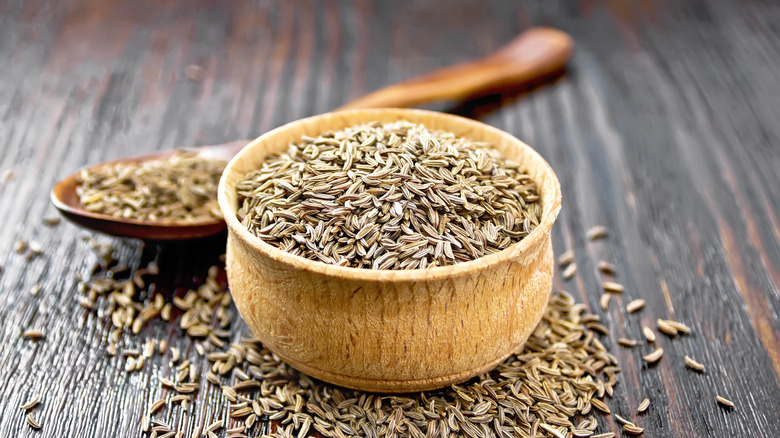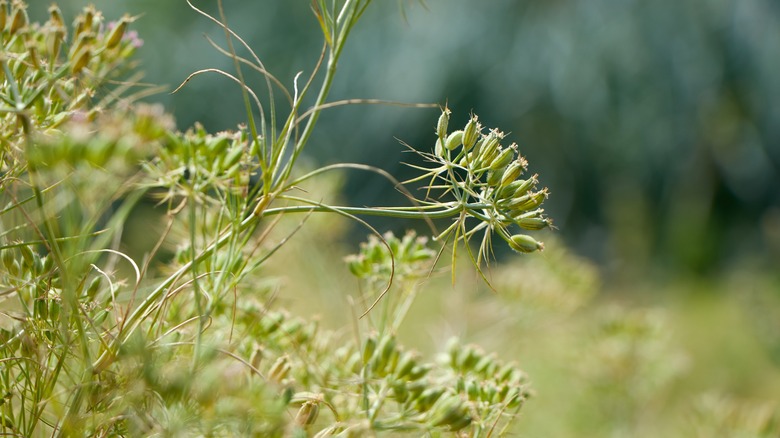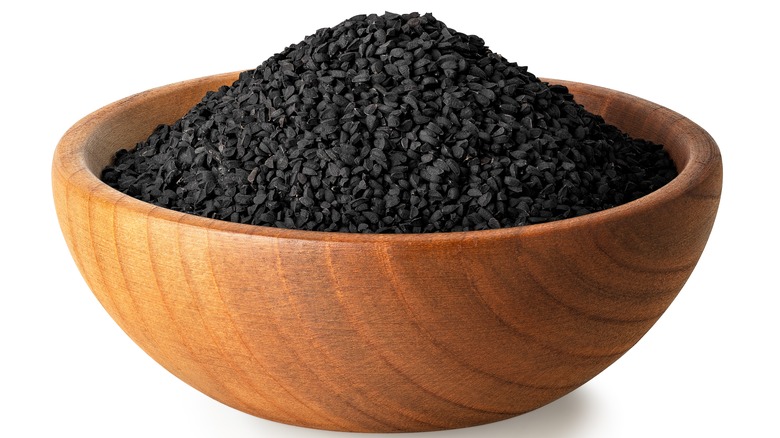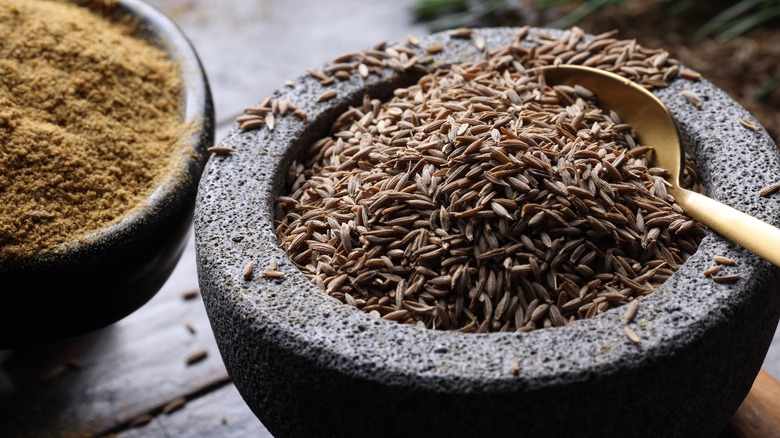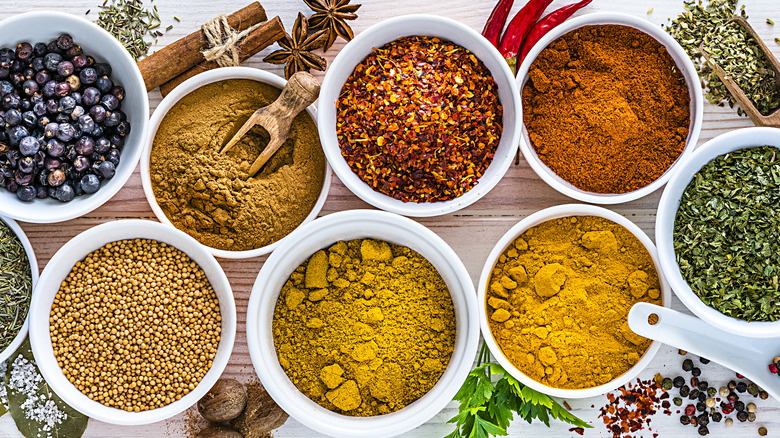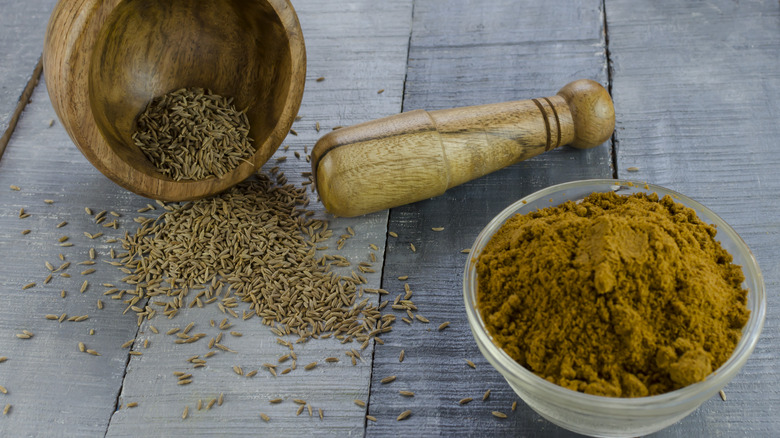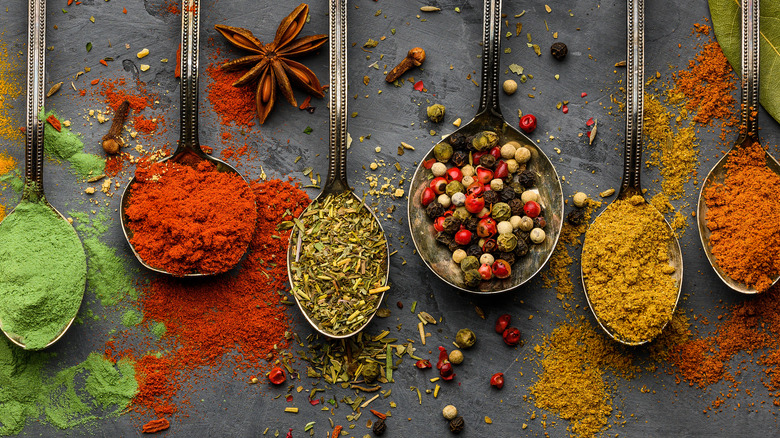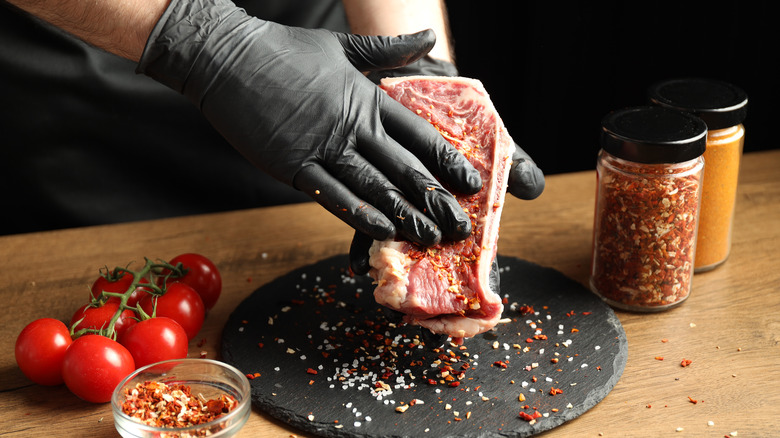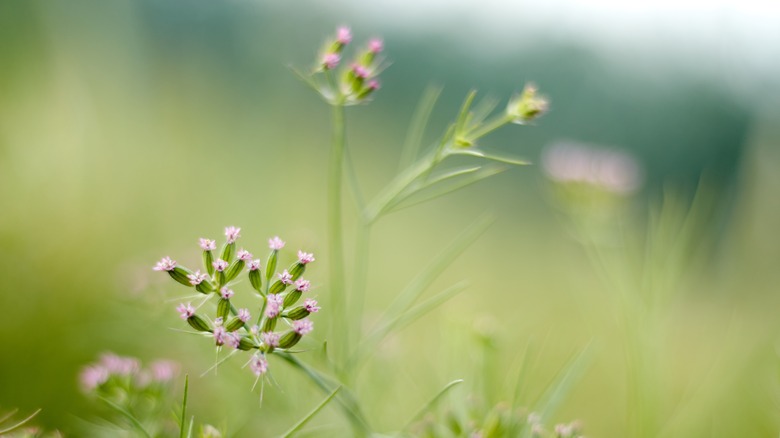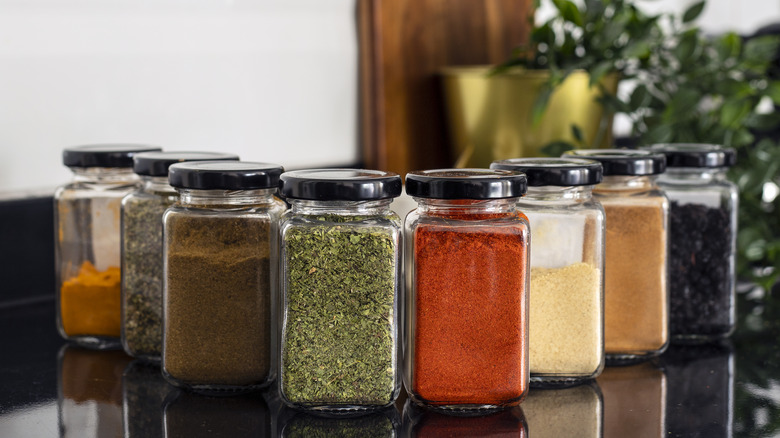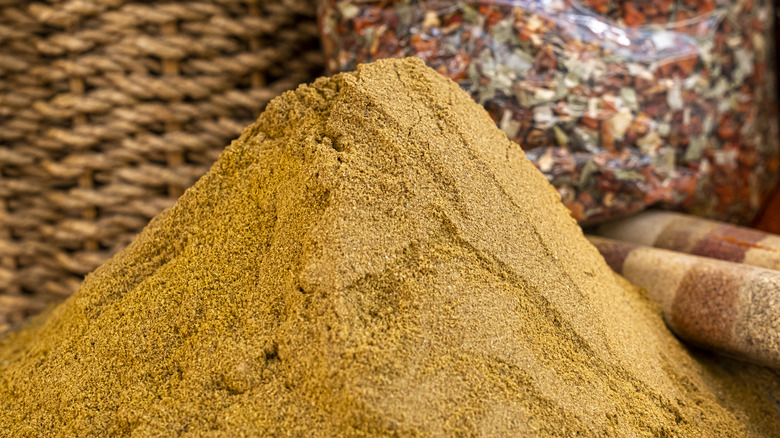Everything You Need To Know About Cooking With Cumin
Cumin is an ingredient beloved across the Mediterranean, Africa, India, China, Mexico, and the Caribbean, as well as other parts of the world. Its warm, spicy-but-not-hot nature lends an inimitable flavor to meat, bread, stew, falafel, and more. It is an essential spice to stock in your cabinet or spice rack, and many culinary experts rank it among their very favorites.
This writer grew up with an Israeli father, so cumin was a part of daily life, used across a wide variety of dishes like kebabs, burgers, and falafel. It is excellent in chicken adobado street tacos or a roasted cauliflower version of the same, and should be your go-to secret ingredient for chili.
However, while many people love the taste of cumin in restaurant and street food, just as many are uncertain about how to cook with it. It's just not that common an ingredient in American cuisine. The good news is, it's not hard to learn to source and cook with cumin, nor is it difficult to store or even grow yourself. Learning to do so will add an extra depth and fascination to your cooking that you simply can't get anywhere else. This guide will show you how.
What is cumin?
Cumin (Cuminum cyminum) is a fluffy, almost weedy-looking plant with green stems and fronds, and white flowers. It is a member of the parsley family, related to dill, caraway, fennel, and cilantro. It looks similar to these herbs in the garden, growing as an annual like them. Other cousins include celery, celeriac, parsnips, and carrots.
Also like these herbs, it is native to the Mediterranean and Iran and has been used in cooking for thousands of years. It is still cultivated in these regions today, as well as in India, China, Mexico, and other parts of Asia. Because it is highly drought-tolerant, you may find it wild in some parts of Europe and Asia, though you must be careful to identify the plant, as it is related to poison hemlock.
Cumin seeds are oblong and light brown, very similar in appearance to fennel and anise seeds, though cumin is darker than their lighter yellow-green color. Cumin seeds are also smaller. These can be eaten cooked whole or, more commonly in many cuisines, ground into a spice powder. The spice is typically harvested by hand.
The ancient history of cumin cultivation and use
The origins of cumin are truly ancient. Literally, cumin made its debut at the dawn of recorded history. The word "cumin" comes from its Sumerian ancestor, "gamun," which has been transliterated from cuneiform first recorded 4,000 years ago. Archeologists have discovered seeds in Syria dated to nearly the same time, in the second millennium BCE, as well as in the tomb of the famous pharoah Tutankhamun.
While the word may refer to either common or black cumin in these ancient texts, what is clear is that this spice predominated in the ancient world of Europe, Africa, and Asia. There are references to it in the Bible, such as in the books of Isaiah (Hebrew Bible) and Matthew (New Testament). In ancient Egypt, it was used in burial practices and even to pay taxes. It was cultivated and consumed extensively by ancient Indians, Greeks, and Romans, traded widely, and brought to the Americas along with the Spanish and Portuguese. Today, it has found its way into many a culinary tradition, spanning the globe from Latin America to the Caribbean to the lands of its birthplace.
Varieties of cumin
The truth is, distinguishing different varieties of cumin from one another is no mean feat, especially given the somewhat confusing information available online and through spice shops. The most common form of cumin, Cuminum cyminum, is brownish yellow in color. This is the one you'll usually find at the grocery store in seed or ground form.
Some sources claim that green and white varieties exist, though they do not specify the botanical names of these different types. A deep dive online indicates that these may be different names for the same type of cumin, perhaps representing linguistic differences or translations or possibly referring to similar plants (like dill and anise) whose seeds are similarly shaped.
Less common and botanically distinct varieties of cumin definitely do exist, such as black cumin (Nigella sativa), also called black seed or black caraway. It is from the Ranunculaceae family. These seeds are grown in very specific regions, such as the Hindu Kush region of Afghanistan. While the flavor profiles are similar, black cumin is milder, more herbal and oniony, and slightly bitter.
Cumin is available as a whole seed, a ground powder, and an essential oil. Which you use will depend on your recipe. It will also depend on availability, since essential oils most likely aren't available at your neighborhood grocery store.
The flavor of cumin
The exact flavor of cumin depends on a number of factors. These include the species, where you buy it, how it was grown, picked, and dried, what form you buy it in, how old it is, what recipe you use it in, and what other flavors you combine it with. As such, as with any other spice or ingredient, it's impossible to nail down the exact taste of cumin.
However, in general, cumin is warm and earthy, redolent of spice without being actually spicy. It is pungent, savory, a tiny bit bitter, and a little bit nutty. These qualities make it excellent for flavoring meat, stews, breads, and more. It is quite a strong flavor, though, and can easily overpower the ones around it, so be careful. To avoid this common cumin mistake, make sure to use the toasted variety, grind it fresh if possible, and add it to your dish slowly.
In order to get the best flavor out of cumin seeds, whether grinding them or not, you need to toast them. Many available ground cumin options are already toasted, but you'll have to look at the label to be sure. For that reason, many cooks choose to buy jeera powder (toasted cumin powder).
How to choose the best spices
The best spices are fresh, plain and simple. Fresh-ground cumin releases a sweet, fresh, bright smell and flavor, so seeds are definitely the better choice if you have the option. Unfortunately, ground spices get stale and lose their flavor much faster than whole ones. You shouldn't keep ground spices around for more than three months, while whole spices last at least twice that long.
For that reason alone, it's more cost-effective to buy whole cumin seeds and grind them yourself. You can usually find these in grocery stores, but if not, there are about a hundred shops online that will sell them. If you're purchasing cumin seeds at a shop, make sure to read the label carefully: They look much like caraway seeds, and both begin with a C!
Whole cumin has another selling point: It doesn't necessarily need to be ground. Whole seeds will soften and disintegrate if cooked into curries, stews, or dal, so you can feel free to add them early in the cooking process and skip grinding. Since spices (unlike, say, produce) come bagged or jarred, you don't need to work that hard to find "good" specimens. Just make sure the company is trustworthy before you purchase, especially if you're going the online route.
How to grind your own cumin seeds
Can you grind your own cumin? Why, yes you can. Many cooks think this is the best way to eat it because the resulting powder is fresher and more aromatic than anything that's been sitting in a jar for months (or years). Think about a clove of nutmeg that you grind versus the cinnamon you buy in a jar. If you've never experimented with whole versus ground spices, cumin is a great way to start.
You can grind cumin seeds at home using a mortar and pestle, spice grinder, food processor, blender, or even a coffee grinder. Raw seeds will become finely ground powder in about 30-40 seconds in a spice grinder. If you want to make roasted cumin powder, also known as jeera powder, you will need to dry roast them on the stovetop first, stirring for five minutes or so then removing from heat and stirring for another two minutes to avoid burning. You can then grind them once completely cool.
Just note that you cannot substitute seeds and powder in a 1:1 ratio. Instead, use a general 4:3 ratio of seeds to ground. Why? Because whole spices take up less space, leaving air holes between them. Ground spices are compact and are, therefore, more flavor-dense. For smaller seeds, such as cumin and caraway, this matters less than larger ones, like coriander. Depending on taste, you may wish to get closer to the 1:1 ratio with your cumin.
Common uses for cumin in the kitchen
Cumin is excellent for meat on the grill, in the oven, or in soups and stews. It is amazing in curries, falafel, kebabs, burgers, and more. It also works well with veggies and grains, bread, and even fried eggs. Many cooks will tell you that cumin is essential to Tex-Mex. And while it is not a critical hummus ingredient, it is a very pleasant addition.
Cumin also works as a flavoring for oil that you can in turn use to add pep to rice, veggies, or lentils. To use it this way, put seeds into hot oil until they bloom, which means to cook them in high-smoke point oil until they crack and pop, releasing the flavors within. Once you smell cumin seeds and they look nice and toasty, you're done. You can then pour everything, seeds and oil alike, over the dish you want to flavor. Just know that if you burn your spices, they will taste truly disgusting. When that happens, as it does to every home cook, start again.
The only thing cumin can't do confidently is dessert. Although there are exceptions, such as apple pie with a cumin glaze, it is, for the most part, a savory ingredient.
Substitutes for cumin
The best substitutes for cumin come in two forms: either one of its close relatives or a spice blend that includes cumin. Straight-across substitutions include seeds from other members of the parsley family, such as coriander (the name for the seeds of cilantro), caraway, dill, or fennel. You should not simply add these in a 1:1 ratio. Rather, look up what the exact ratio is online. For instance, you should only use half the amount of coriander when substituting for cumin.
Spice mixes that imitate cumin's heat and earthiness can also work. Spice blends that include cumin are numerous. Some of the most common options include taco seasoning, curry powder, garam masala, and chili powder. Some further-afield options include nutmeg, allspice, or celery seeds, which will at least give depth to your dish, even if it won't taste exactly as it would with ground or whole cumin.
Remember when substituting to start small. You can always add more of your chosen substitute later, but rectifying a dish that wasn't supposed to have nutmeg at all and now has way too much of it is difficult unless you're a witch. Which, probably, you're not. After looking up substitutes to find the correct ratio, you should still add cautiously.
Homemade cumin spice mixtures
Cumin is a wonderful spice that plays well in a number of homemade spice mixtures. Flavors that go well with cumin include thyme, cinnamon, turmeric, red pepper, and oregano, among others. Which you choose to mix it with will depend on the cuisine you're using.
For instance, chili powder recipes call for paprika, oregano, garlic and onion powder, and cayenne, along with cumin. This works well for chili, tacos, and other Tex-Mex-inspired fare. Middle Eastern baharat combines coriander, nutmeg, cinnamon, cardamom, cloves, paprika, and cumin. Za'atar is another Middle Eastern seasoning blend, made of sumac, sesame, thyme or oregano, and cumin, among other potential flavors. Both Middle Eastern mixes are wonderful for meat, fish, and vegetables alike.
If you don't bother with specific spice blends but want to experiment with the flavor of cumin more, consider adding it to a steak dry rub. You can use a variety of herbs, peppers, salt, and sugar to achieve the effect that suits your tastebuds best.
Growing your own cumin
Cumin is actually quite easy to grow. Like its cousins parsley, dill, fennel, or cilantro, it grows as an annual. You can start it indoors 8-10 weeks before the last frost date and transplant it to the garden after the chance of frost has passed, or you can direct sow it four weeks after the last frost. You can also grow it indoors in a container any time of year.
To collect the seeds, you must wait until the flowers form, then hang the plants upside down to dry. Place a container or bag below the plant after you hang it up. This will catch seeds as they fall, which they will do once dry and ready. You can use your seeds whole, grind them into a powder, or use them to plant more cumin the next year. Just make sure the seeds are completely dry before putting them in a container, or they might mold.
Note, however, that cumin can be fussy. The plants need warm weather to develop as well as plenty of room in the garden: about 4-6 inches between each plant. Plan 3-5 months from planting to harvesting.
Health benefits of cumin
Common cumin has long been used in traditional medicine, such as in the treatment of cancer, diabetes, and low cholesterol. It may assist in digestion, urination, reducing inflammation, reducing muscle spasms, and more. It may also be effective in weight loss.
Black cumin also brings a raft of health benefits to the table. It also helps with immunity and inflammation and can increase the health of a number of different systems in the body. Research shows that it works as an antidote to toxins and drug side effects and may fight cancer, just like its common cousin.
Always consult a doctor or herbalist if you are going to add a significant amount of any herb or spice to your diet. Many of them have unintended consequences or are contraindicated for certain medicines. Also, many of the specific benefits of black or common cumin may not translate to the other, and a professional can help you get it right.
Storing cumin to last
Sadly, most people are working with expired goods. While spices don't go bad in the way that tuna will (e.g., could kill you, serious barfing at minimum), they still go off. One of the best ways to prevent this is to buy whole cumin. As with fresh fruit, you can keep spices good longer by keeping their natural outer coverings intact. Because cumin is relatively easy to grind, either by hand or in an appliance, this is not a hard switch to make.
In general, though, cumin is easy to store. For the best flavor, keep it and other spices in a cool, dry place using an airtight storage jar. A dark cabinet or drawer is ideal. If you open the jar and can't smell anything, then you should buy new cumin if possible. Much of the experience of taste comes from smell, so a lack thereof signals a significant degradation in the quality of the flavor. It's not a bad idea to label your jars with the date of purchase so you can throw them out within their best-by window. For ground spices, that's roughly three months. Whole cumin lasts about a year.
Nutritional information
Cumin is a spice and therefore does not contribute measurably to the calorie count of a dish. A teaspoon of whole cumin seeds has roughly 8 calories, so you'd have to consume a whole lot of it to break your diet. Neither is it a particularly good source of nutrients. While it does contain important minerals such as calcium, magnesium, phosphorous, and potassium, these are in small quantities, with trace amounts of many other vitamins and minerals.
However, humans need to get these trace minerals from many sources. They are important for a number of metabolic processes, and without them, you are at greater risk for disease. They are also important for the proper development of children, so ensuring a hefty dose of different spices in your kiddos' diet is a good idea. Overall, adding cumin to your culinary routine is a good way to up the wellness ante. Just another reason to start cooking with cumin today.
